 Hundreds of aircraft have raced at Reno since 1964, but some stand out for their superior win record, outright speed, numbers produced, introduction of new technology or some other reason. Here is a sampling—by no means complete—of the more significant or representative Experimentals spawned or made famous by Reno.
Hundreds of aircraft have raced at Reno since 1964, but some stand out for their superior win record, outright speed, numbers produced, introduction of new technology or some other reason. Here is a sampling—by no means complete—of the more significant or representative Experimentals spawned or made famous by Reno.
Formula 1
The thoroughbreds of pylon air racing, as a class the diminutive Formula 1s are the only aircraft designed specifically for racing. Every one is a homebuilt, with many interesting to downright exotic one-off designs in the F1 history book. Defined by a narrow set of rules requiring an internally stock Continental O-200 engine, these taut little specialists are trailered to the airport because they’re too twitchy and range limited for anything other than pylon racing. But they’re oh so rewarding at speed.
More than any other class, Formula 1 winners result from endless tinkering and attention to detail from their hands-on owners. The emphasis is aerodynamics and reduced weight, with engine power effectively capped by the inherent limitations of the venerable Continental. Thus, continuous thought on shaping the airflow around these little racers is F1 standard operating procedure, making it a great place for those who like to build.
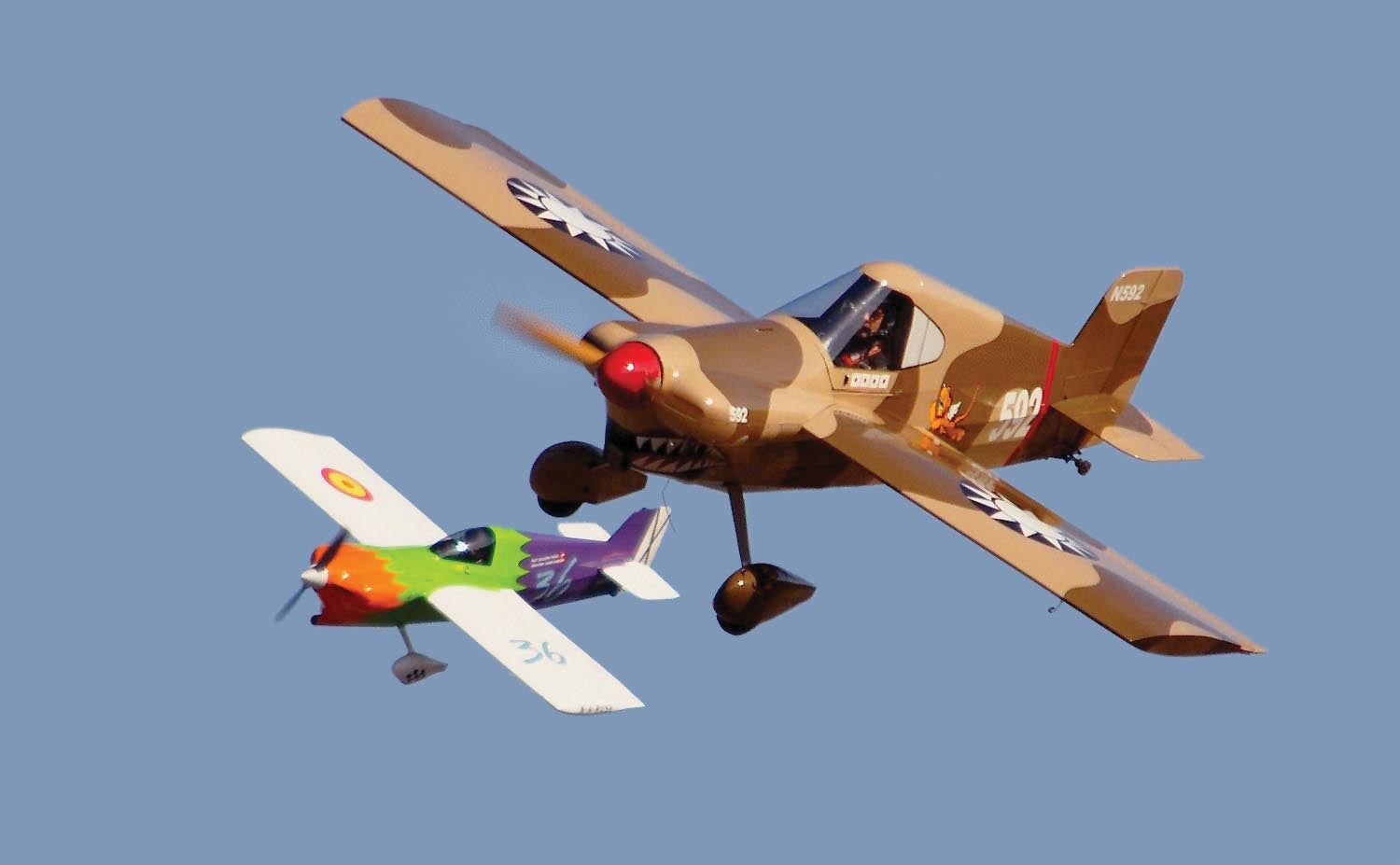
Cassutt
All Formula 1 discussions begin with the ancient Hershey-bar wing Cassutt. Tom Cassutt’s stone-simple 1954 rag-and-tube design far predates Reno yet remains the practical first-time racer because they are cheap, easy to build and relatively simple to fly. There are also a bunch of them around in the backs of hangars waiting for some TLC. Of course, those characteristics guaranteeing easy access to pylon racing also guarantee you’ll never win anything with a stock Cassutt, but as a starter racer it is without peer.
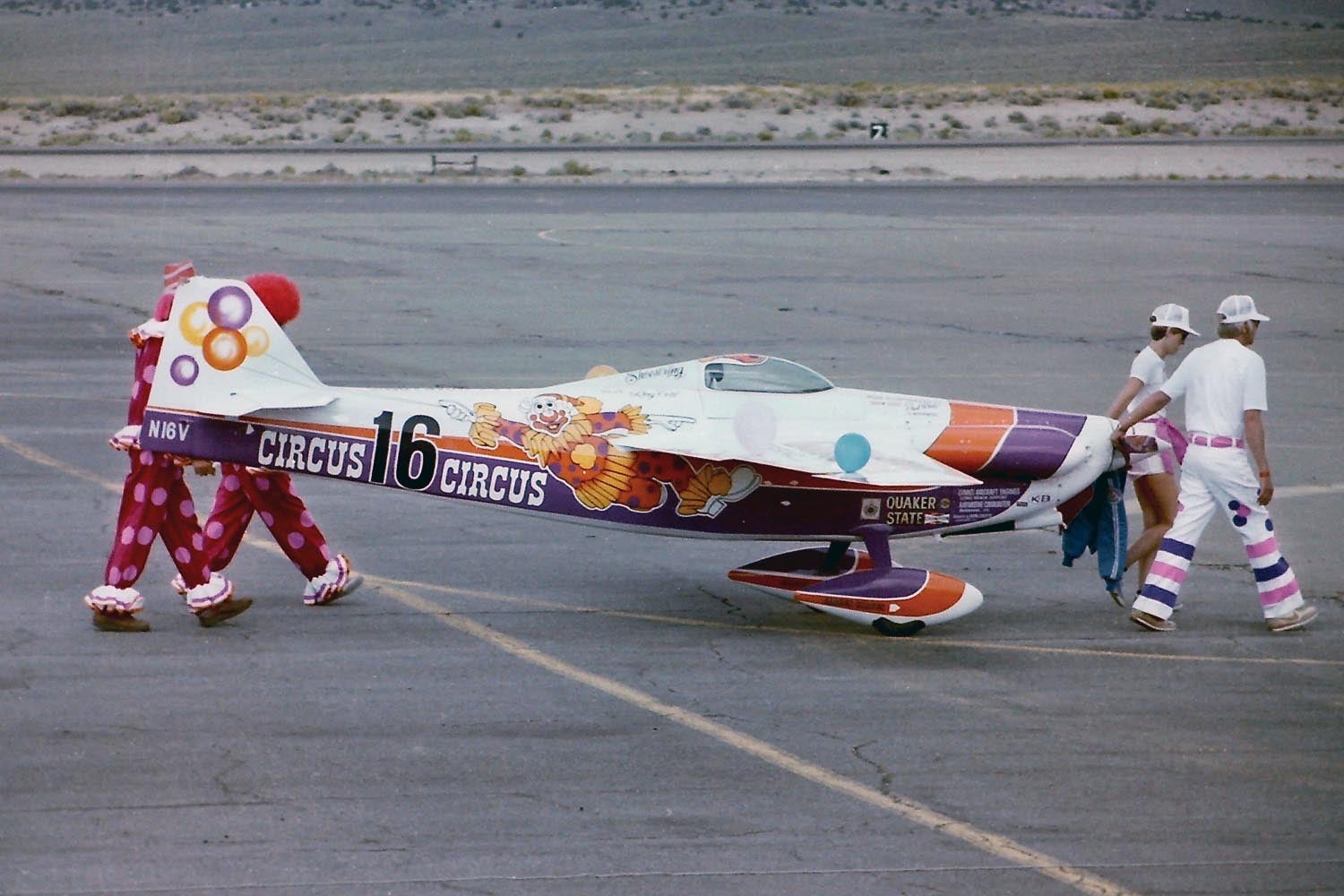
Shoestring
An early, dominating design penned by Rodney Kreimendahl, a Lockheed engineer in the late 1940s, Shoestring was built by Vince and Carl Ast in Van Nuys, California, with a steel-tube fuselage truss and a one-piece wooden wing. There were no plans initially, but a set was developed by reverse engineering the original Shoestring and ultimately several clones were plansbuilt. With its rotund belly and rounded wingtips, Shoestring defied the squared-off aerodynamic thinking of its day, but proved a fast, streamlined shape. Ray Cote of San Diego, California, made Shoestring famous by developing it to nine National Championships, eight of them consecutively, 1968–1975. All were won at Reno. The easy-flying design provided the jumping-off point for the current Snoshoo (iS NO SHOEstring) known as Limitless.
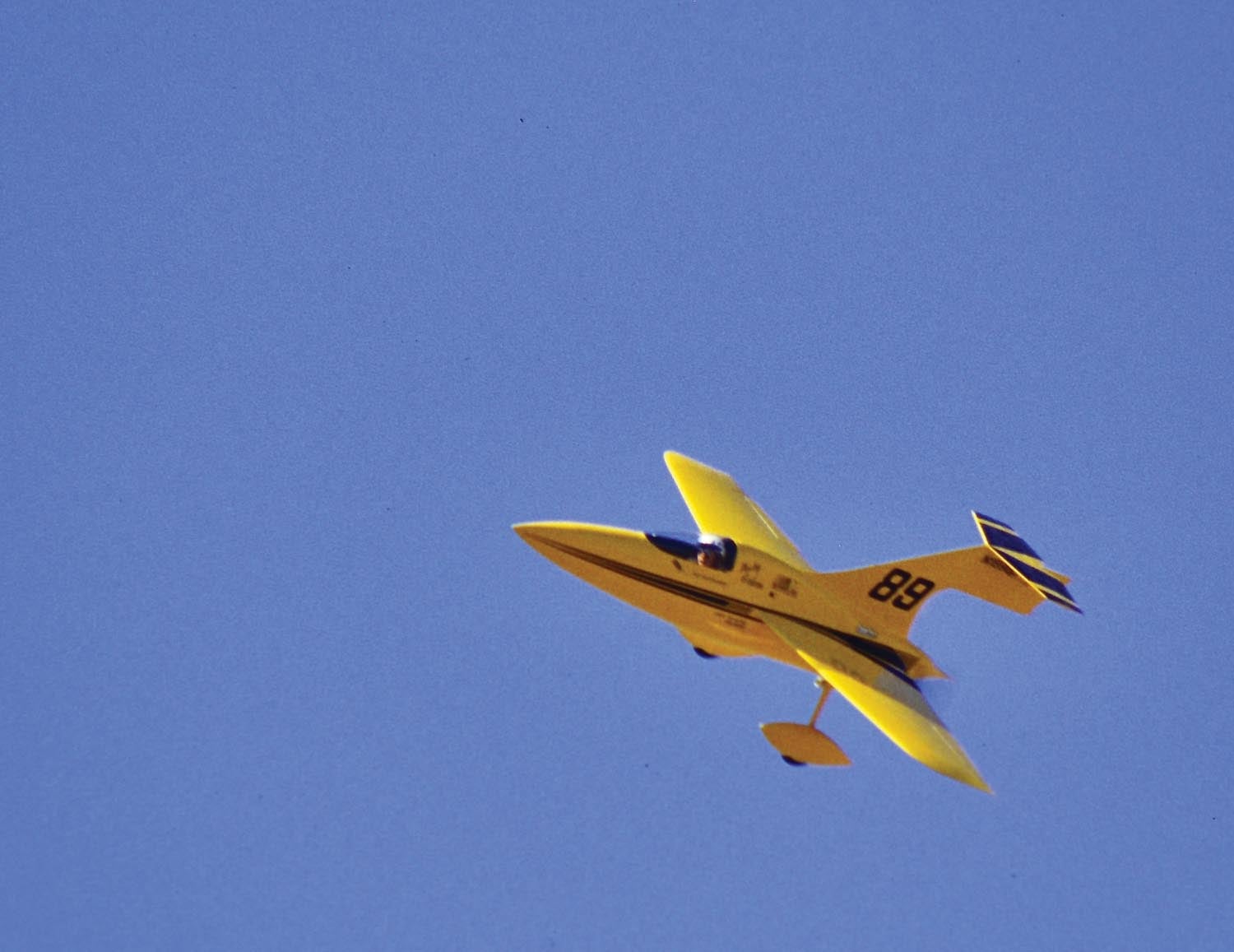
Pushy Galore
Not the first pusher in the Midget/F1 world, Pushy Galore was easily the most successful even though its highest Reno finish was second in the Gold in 1990. Top qualifier in 1989 at 236 mph, this Miller Special did not lack for speed and set several speed and climb records with Bruce Bohanan at the controls. Its C-1A time-to-climb record to 6000 meters is 12 minutes and 50 seconds, for example, and it was never defeated in the AeroShell 3D Dashes held outside of Reno. Several Miller Specials were built by Jim Miller, a creative and successful racer and aircraft modifier (his Miller Mod Piper Comanches are a good example) based in San Antonio, Texas. His Specials used a conventional steel tube structure covered in a carbon fiber shell, a method still favored by some in F1 today.
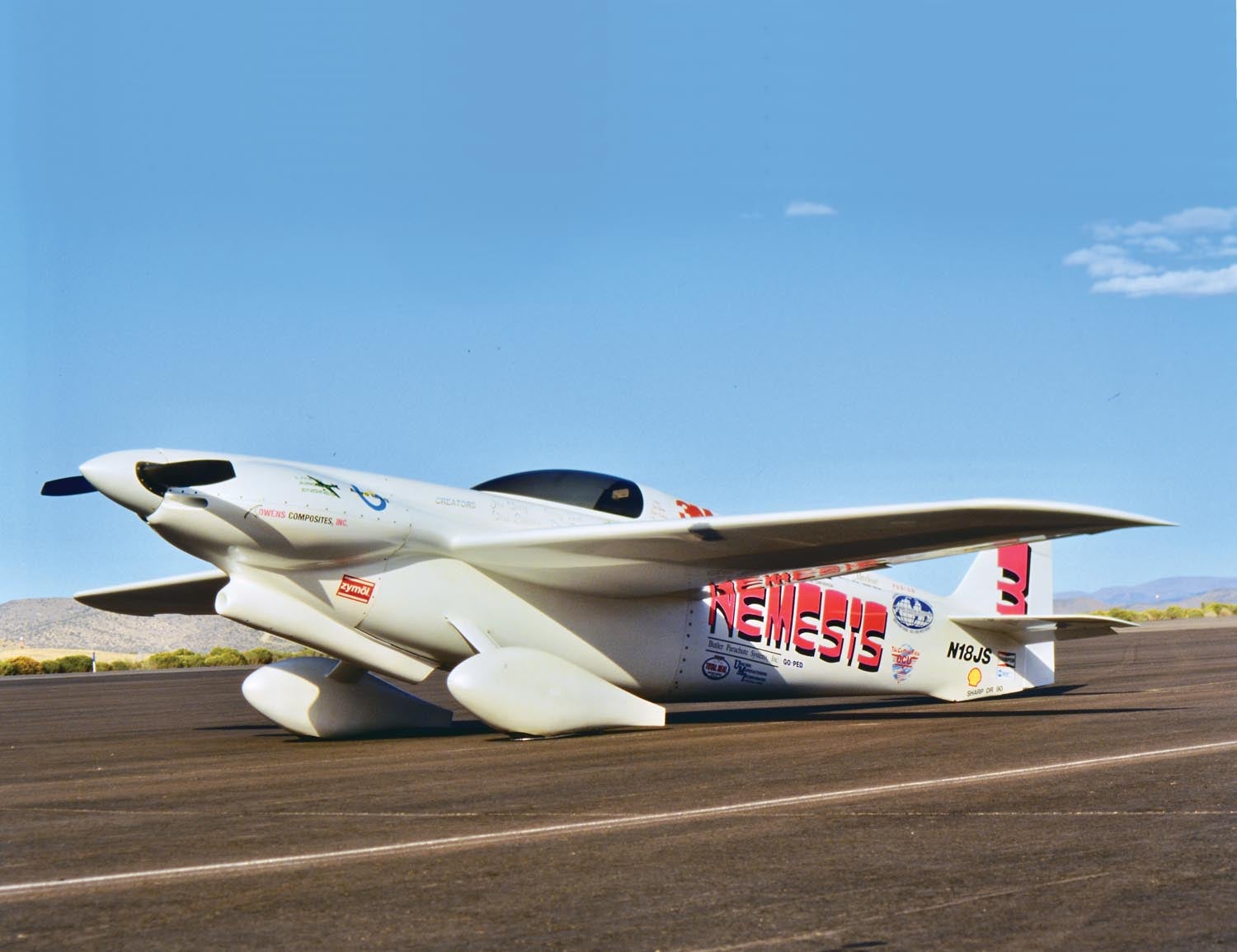
Nemesis
When Lockheed engineer Jon Sharp leveraged the talents of his Lockheed coworkers to birth Nemesis, he did nothing less than usher in a new age of all-composite F1 racers. Sweeping all before it from 1991 to its retirement to the Smithsonian National Air & Space Museum in 1999 with 47 wins out of 50 races entered, the fastest F1 lap time ever recorded to this day and nine consecutive F1 Gold titles 1991–’99, Nemesis put composite construction to best use, maximizing interior volume for the very tall Sharp while minimizing exterior dimensions and taking weight to new lows. Nemesis set 16 world speed records while demonstrating incredible 290-mph straight-and-level speed from an O-200 Continental. Nemesis also earned four Louis Blériot Medals and four Pulitzer Trophies. Like other racers, continually updating Nemesis aerodynamics in search of “nano knots” played a part in its continued dominance. If anything bad can be said about Nemesis, it is the airplane was so superior it dampened enthusiasm for the Formula 1 class because race outcomes were preordained.
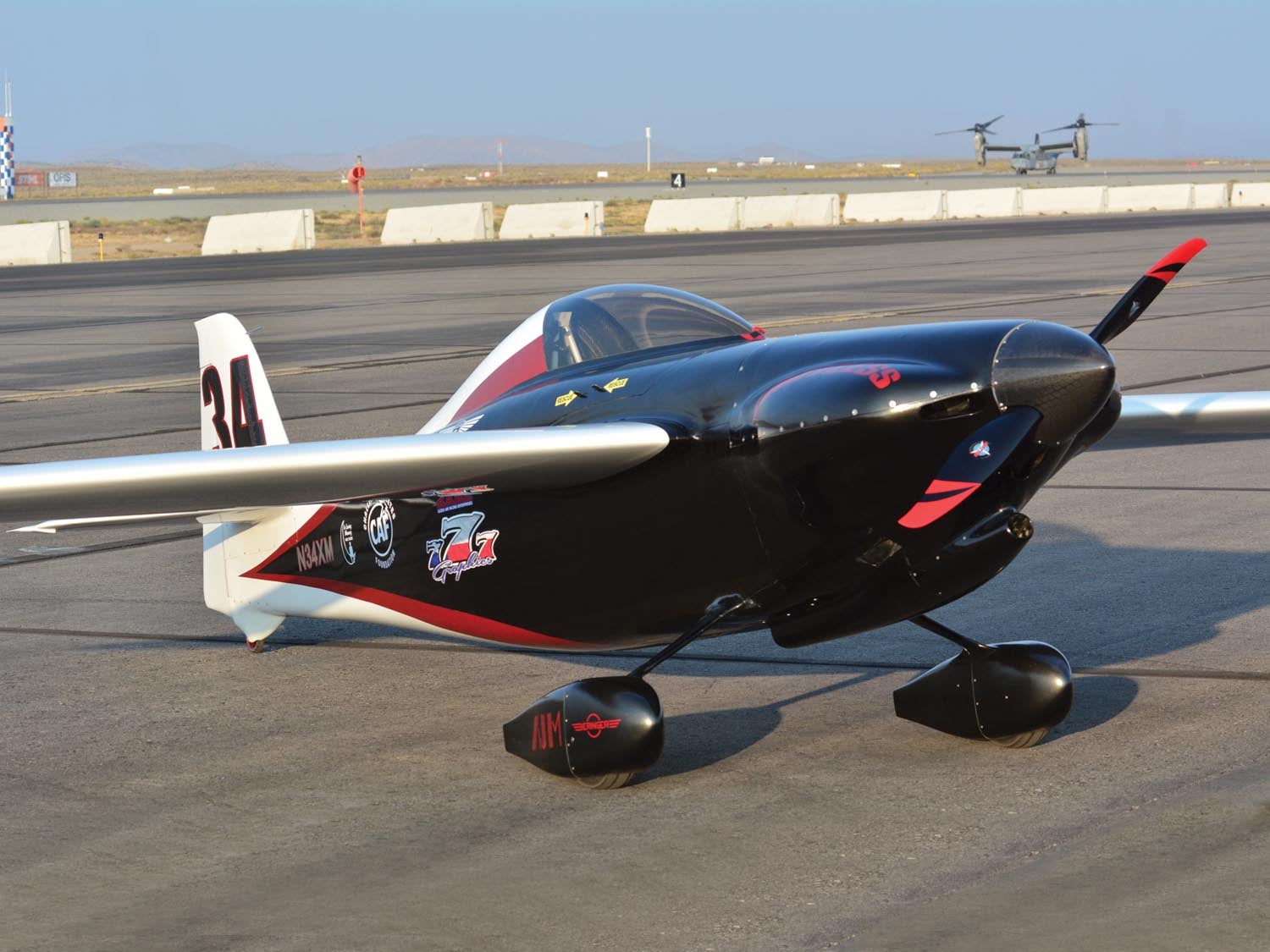
Limitless
Reigning F1 champion Justin Meader’s Snoshoo SR-1 employs some traditional construction with hard-won details. The fuselage is a steel truss but covered with carbon fiber skins, while the carbon fiber Catto-built wing, designed by Paulo Iscold, features a natural laminar flow. Looking to support more Snoshoo builds, the fuselage skins are from female molds, and the Snoshoo design is serviced by Van Meter/Smith Racing (VSR), such that the Snoshoo is a well-supported plansbuilt airplane. That’s a rarity in F1, especially for the current Gold champion. Meaders builds his own engines, along with his own hand controls, as he uses a wheelchair after a motorcycle accident. Dedication to testing is another hallmark of his team and a big reason why Limitless won the Gold race its first year at Reno.
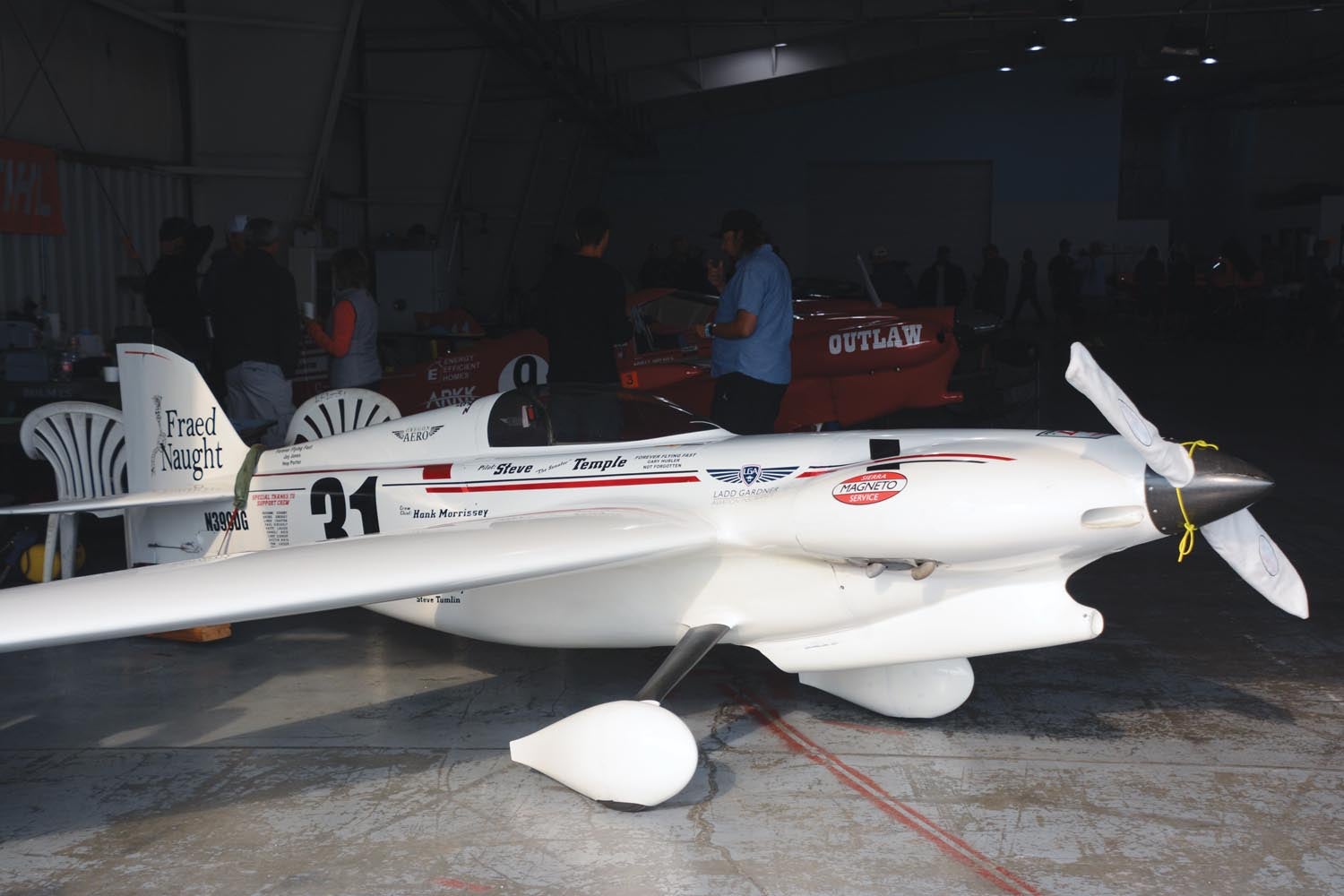
Fraed Naught
With the best name in air racing, the DG-2 Fraed Naught is the other top Gold F1 racer today and typically trades Gold wins with Limitless. Its pedigree spans decades of F1 racing, the line starting with a George Owl fuselage that Jon Sharp abandoned as too tight for his large frame. Jon sold the plane to Dan Gilbert, who put a new wing and tail on it to make the DG-1. Long-time Fraed Naught owner Lowell Slatter says, “It went real fast but wouldn’t turn.” Trying again with the DG-2 that became Fraed Naught, Gilbert built a new all carbon fiber fuselage that’s pretty much a ⅞-scale Nemesis. Yet another new laminar-flow carbon wing designed for minimal induced drag up to 4 G’s emerged from Craig Catto’s shop, and Lowell Slatter has taken the combination to three Gold wins before selling it to Steve Temple last year and having newest owner Josh Watson take the Gold again this year.
Biplane
When Reno started in 1964, sport biplanes were tiny, plansbuilt single-seaters following traditional rag-and-tube construction. The Pitts Special was rapidly making a name for itself, the Starduster was well-established, Mong Sports were seemingly as numerous as they’d ever be and the relatively rare, prewar Knight Twister with its tiny wings was the speed demon of the bunch. Engines were smaller than is popular today, the O-290 Lycoming something of the standard and speeds were modest, with backmarkers not breaking 150 mph. For years considered a class to fill in the show schedule, Biplane emerged as a serious Experimental outlet in the 1970s and early 1980s. Sleek, pure-racing one-off designs took speeds over 200 mph, only to have the rank-and-file members feel left out and legislate the fast designs out of business. Eventually the rules were relaxed so that today hot-rodded 360-cubic-inch engines and crafty airframes are allowed.
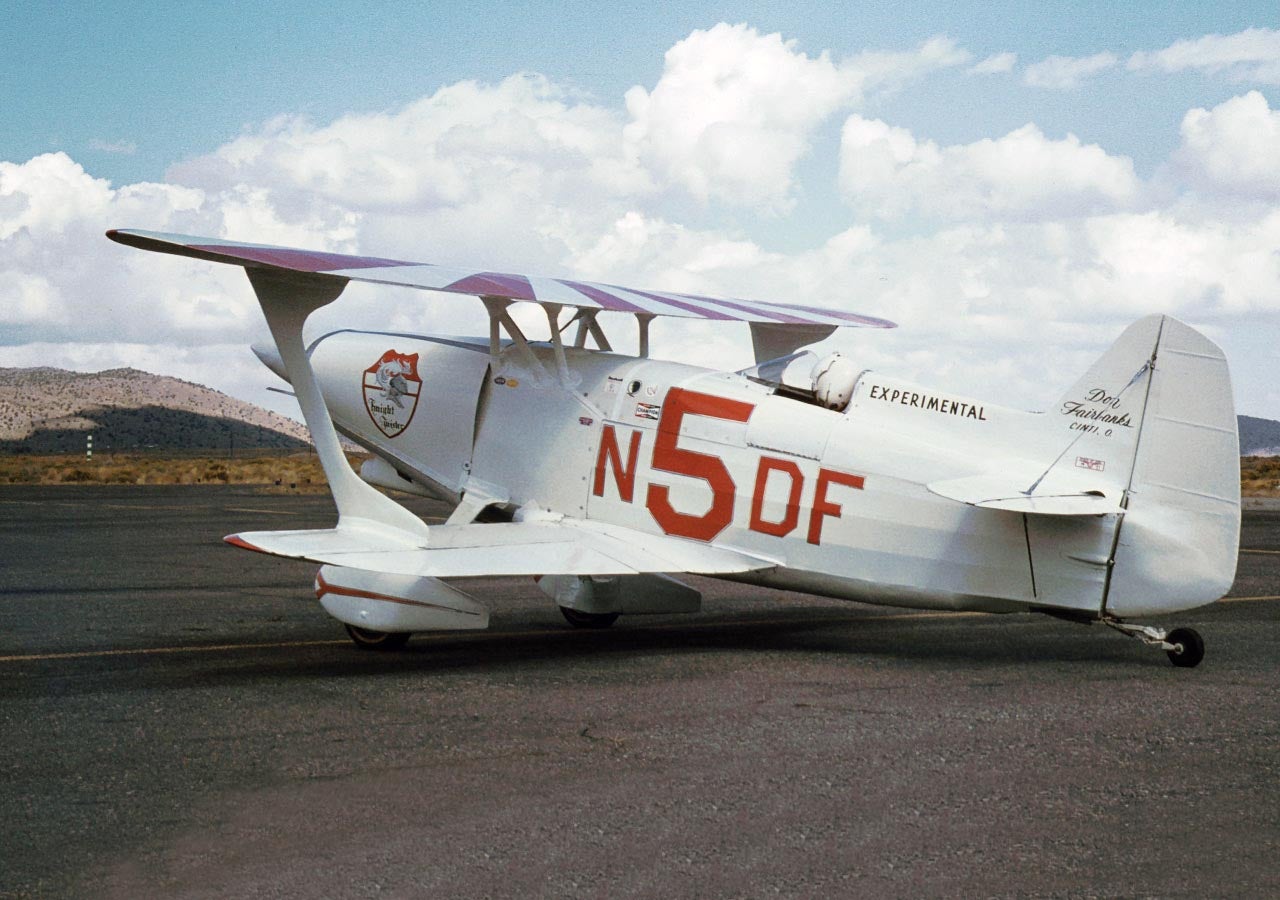
Knight Twister
A prewar plansbuilt with several wing options, the stubby Twister did well in early Biplane competition. Unusually short span, small-area cantilever wings—no wires—were the main advantage. The short wing was eventually disallowed by the Biplane class’s minimum wing area rule and the type faded from racing. Today there is one Knight Twister coming together with a class-legal wing, so the venerable design hasn’t truly disappeared.
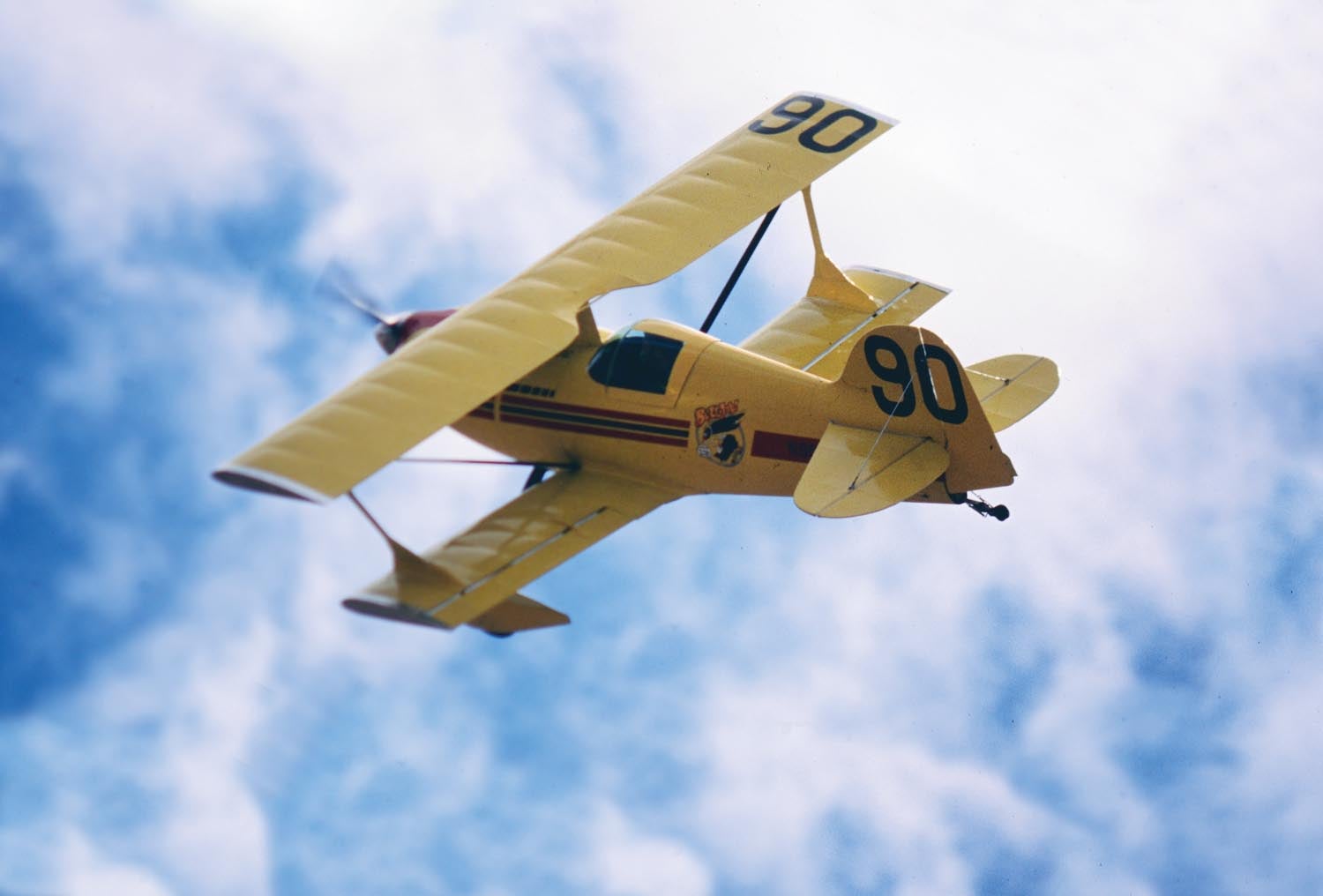
Mong Sport
Ralph Mong was a diminutive man said to stand 5 feet 4 inches tall, which seemed correct the few times we spoke with him. He designed his tiny sport biplane to fit him, saying all the other designs were for big guys. That small size gives the Mong Sport unusually low drag for an otherwise conventional biplane and several Mong Sports figured prominently in 1960s Biplane racing all the way to the new millennium. It’s a design that punched well above its weight in Biplane competition.
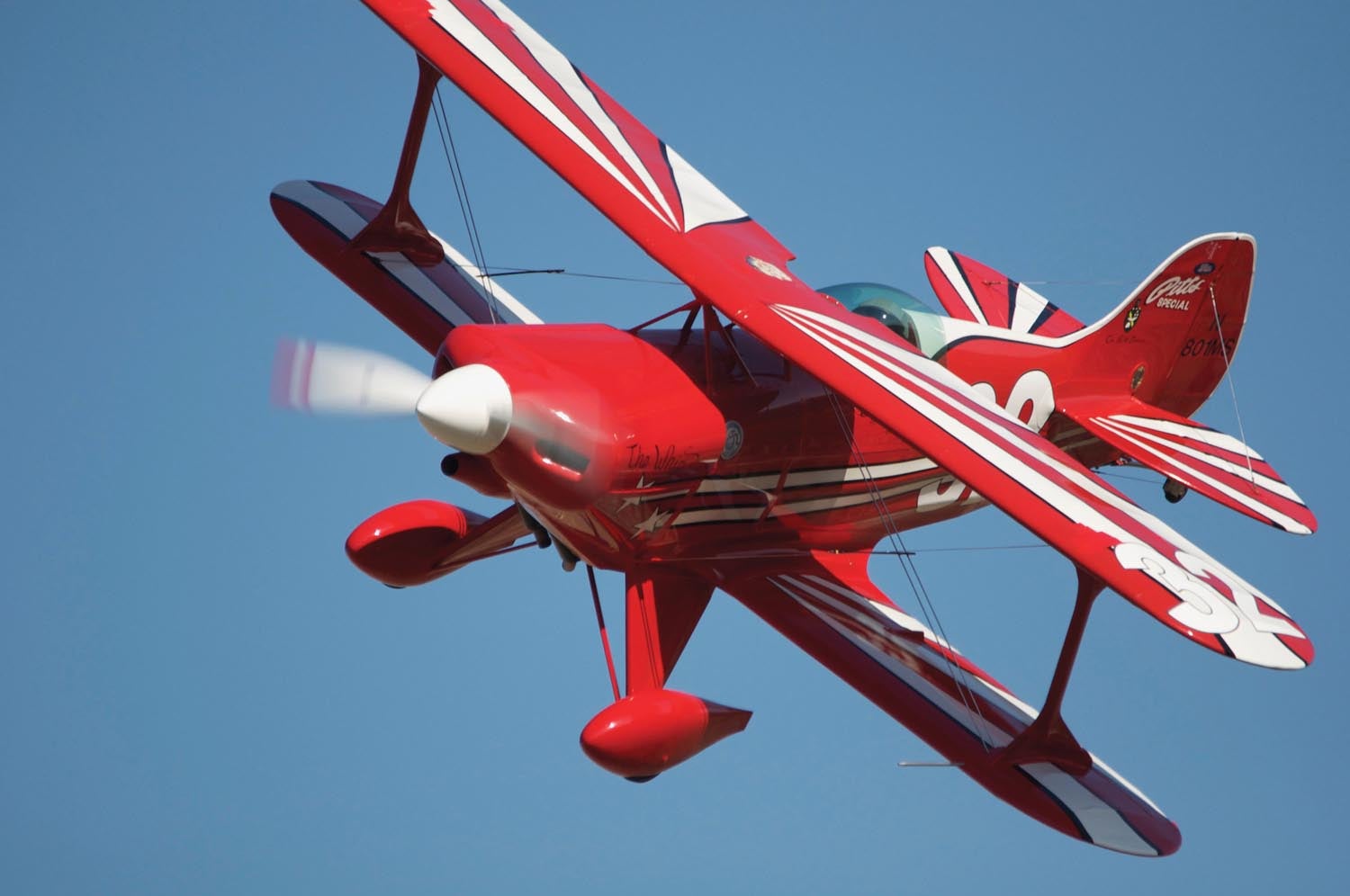
Pitts Special
Already popular for general sport flying and aerobatics, the Pitts Special, especially the S-1C with ailerons on the lower wing only, was a shoo-in for Biplane numerical supremacy. Available, conventional and easy to modify for reduced drag and more power, the Pitts is the backbone of the Biplane class, and it can be found in any state of race tune. Good examples are Second Hand, a mainly conventional Pitts assembled from existing spare parts; Bad Mojo/Smokin’ Hot, boasting decades of racing modifications; and Miss Gianna, with all new cantilever carbon fiber wings.
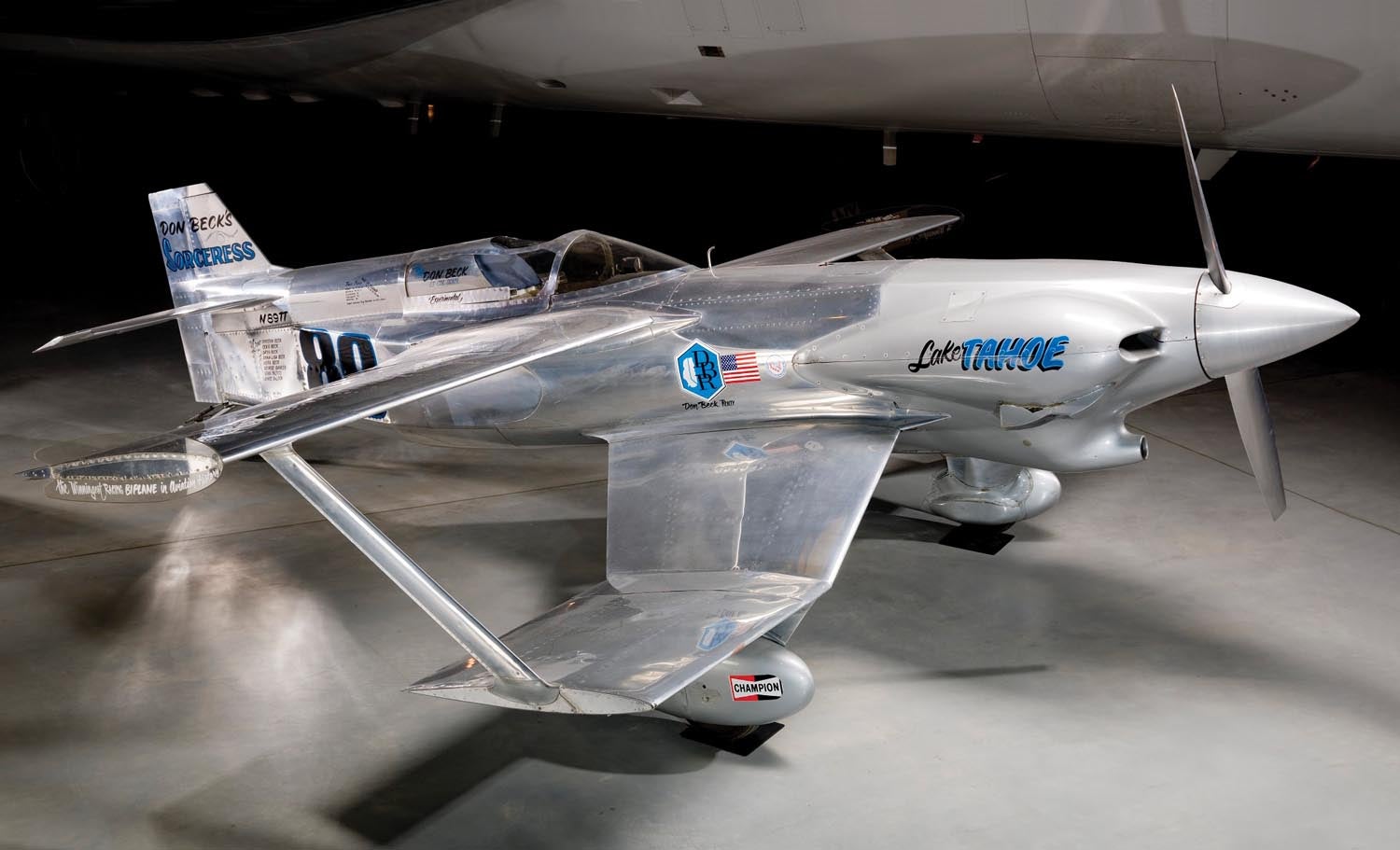
Beck-Mahoney Sorceress
Able to get by on looks alone, Sorceress exemplifies the high-tech, advanced designs that shook up the Biplane class in the 1970s. Father and son Lee and Sheldon Mahoney designed and built Sorceress, with Don Beck taking over from them. Lee Mahoney’s background included composites, composite-to-aluminum bonding and computational fluid dynamics, when such things were more science fiction than reality; all of them went into Sorceress. The reverse stagger wings were designed with mirroring airfoil sections so one would take over from the other in the turns, and the little O-290 engine’s exhaust was routed to keep airflow attached to the fuselage, enabling a smaller vertical tail. Sorceress worked: It was the first biplane to post a 200-plus-mph lap and won the Reno Biplane Gold in 1972, 1975 and 1976 before shortsighted rules changes relegated it to the Smithsonian National Air & Space Museum.
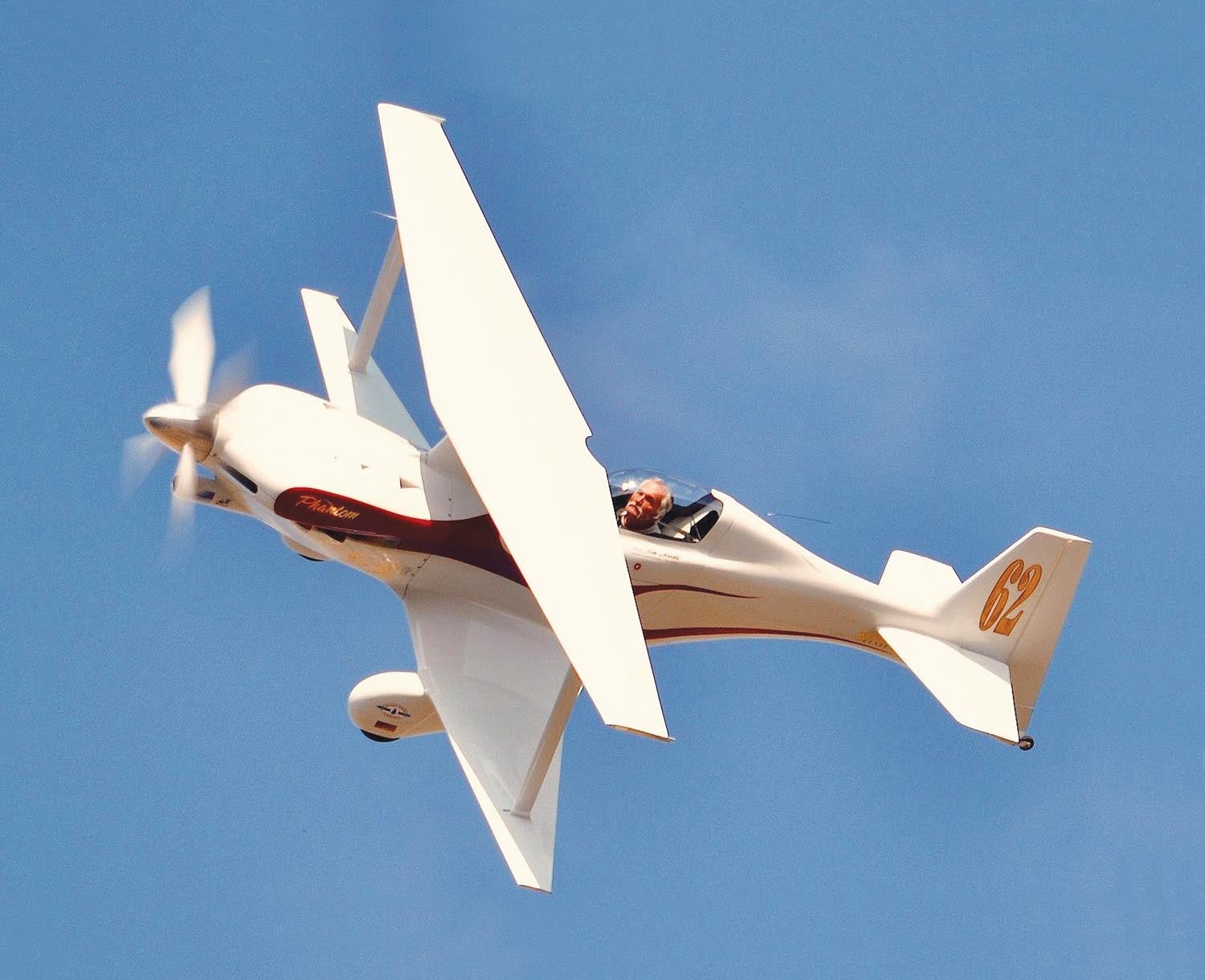
Phantom
Dedicated to biplane racing, Tom Aberle ran a string of Mong Sport, Starduster and Pitts Specials at Reno intermittently from 1968 to 2015. His magnum opus Phantom resulted when Tom joined with Andrew Buehler, who owned a spare Mong Sport; Chris Piedemonte, who had the money; Robbie Grove, for a set of carbon wings; Ly-Con, for monster 360-cube power; along with a handful of skilled racing friends and fabricators who hammered out the plane in just eight months of near-around-the-clock labor. Starting as a Mong Sport, Phantom was blessed with surprisingly small frontal area that was coupled to low-drag updraft cooling, almost embarrassing Ly-Con power and very trick Lipps propellers. With Tom’s steady hand on a very nervous stick, it yielded 280-plus-mph speeds. Phantom is an enthusiast’s triumph; Lockheed had nothing to do with this one. Rather, it was the culmination of Tom’s extensive pylon experience and “that looks about right” engineering.
Sport
Celebrating its 25th year as a class as Reno bows out, Sport spans a huge gulf ranging from stock RVs at the Medallion/Bronze entry level to full-race, 900-hp Glasairs and Lancairs in the hairy 400-mph Gold division. Modifications are conventional at the lower levels, but in the Gold a handful of racers revel in Sport’s liberal engine rules. Anything goes as long as the engine or engines displace a total of 1000 cubic inches or less (no one has yet come close to approaching the displacement limit) and any power adder (turbos, blowers, nitrous) is legal. Initially Sport was seen as a way to showcase popular kit aircraft, so the rules required five or more airframe kits be available and seating for two. But even that has gone away as single-seaters are now welcome, as are one-off race planes.
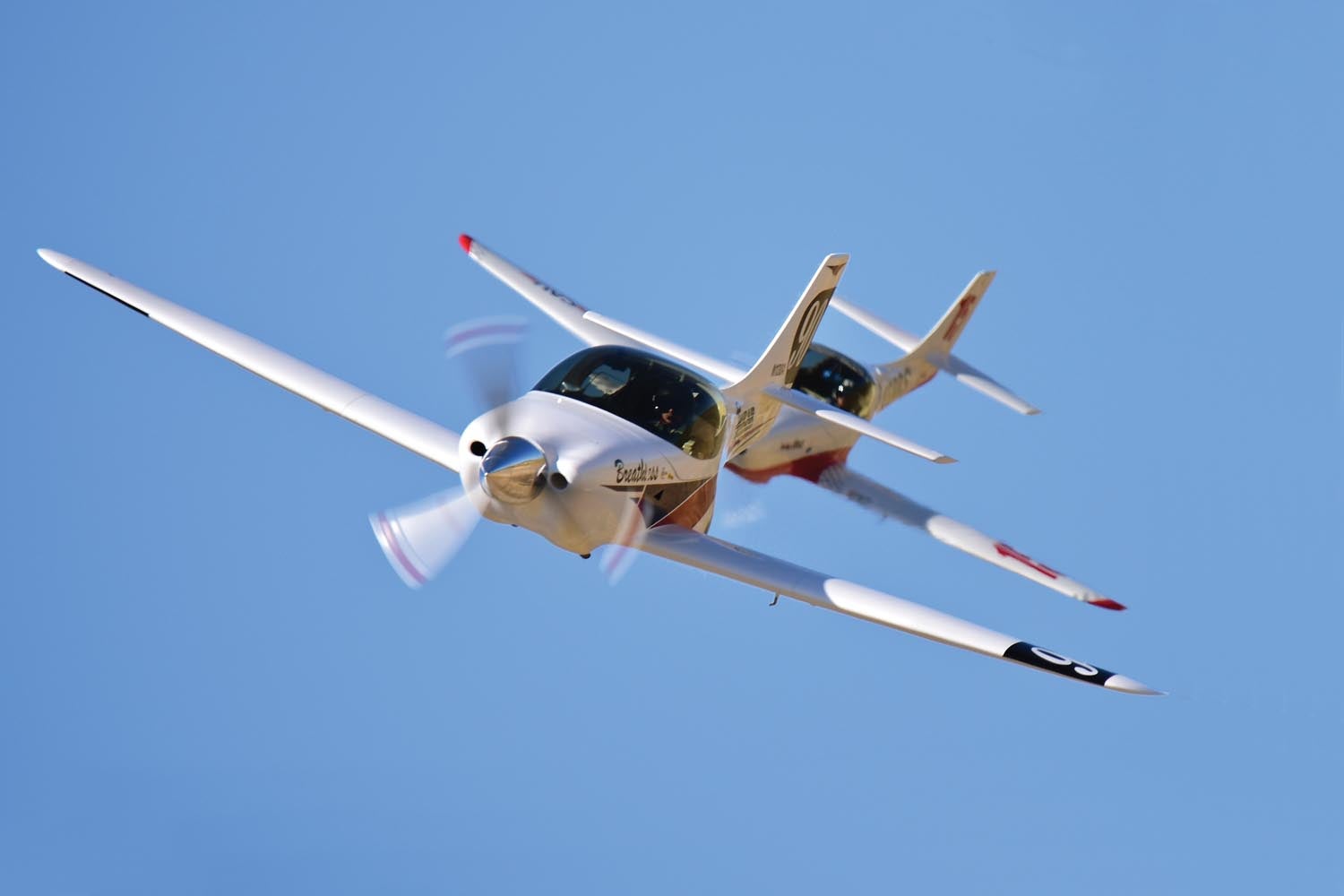
Breathless
Built in 2002 by Andy Chiavetta and made famous by Sport main man Lee Behel, Breathless does not have such an impressive record at first glance, just a single Sport Gold title in 2008 with Behel at the stick plus two additional Gold podium finishes. But when you understand Breathless is naturally aspirated in a class teeming with turbochargers, the plane’s stats become more impressive and its name more understandable. Running consistent 331- to 335-mph laps using an IO-550 Continental, Breathless will give any normally aspirated plastic fantastic a real run for its money. Furthermore, with some of Chiavetta’s sturdy construction and important race mods such as a rear-hinged canopy (guaranteed to jettison on demand), feathering prop (better dead- stick glide) and a beluga belly (less concave aft fuselage for reduced aero drag), Breathless is also notably heavy. No matter, it’s still an amazingly fast airframe.
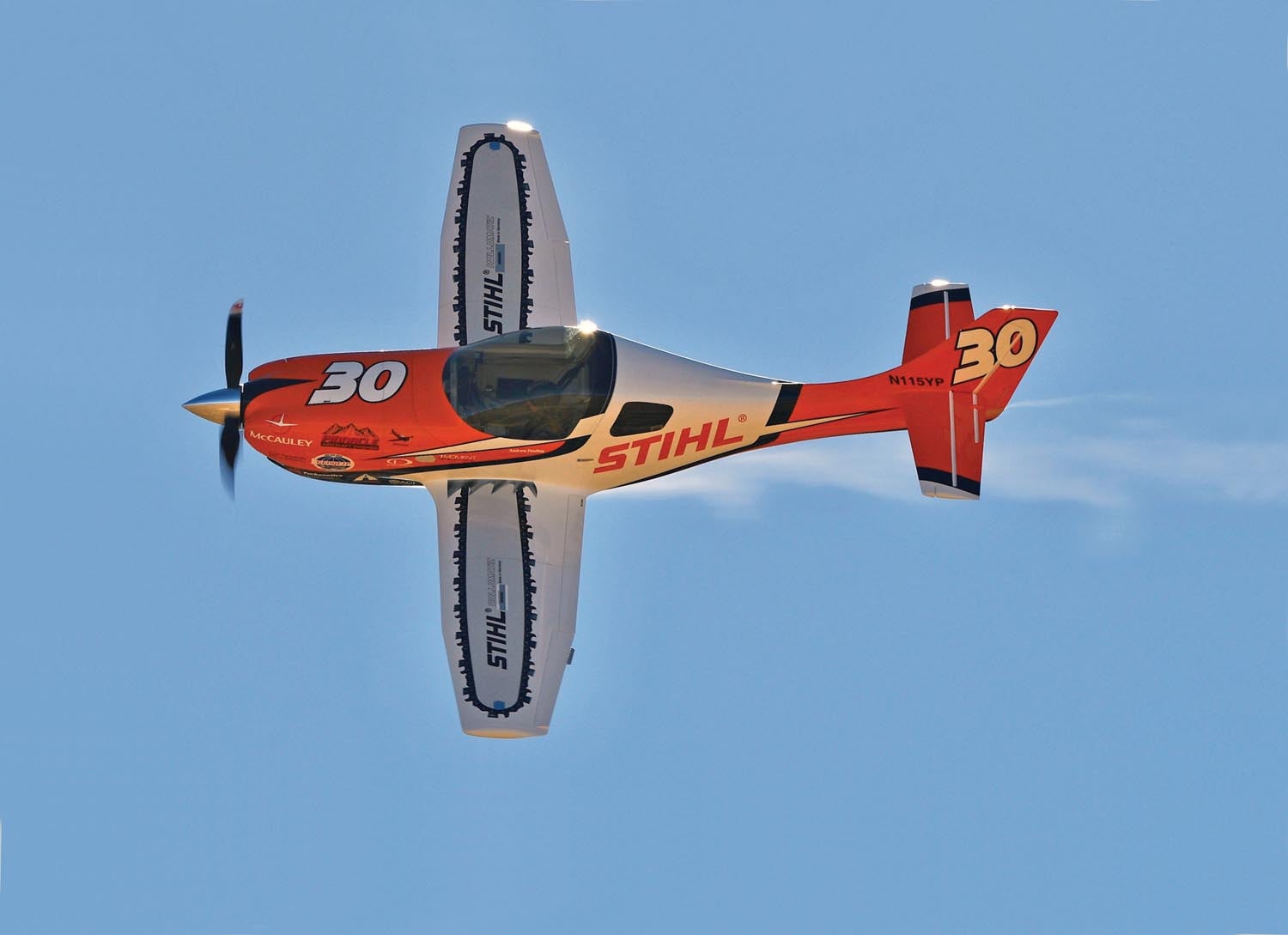
Lancair Super Legacy—Findlay
At the fast end of the Sport class, the most popular airframe is the Lancair Legacy—and there is no more recognizable Legacy than Andrew Findlay’s with its distinctive STIHL sponsorship. That sponsorship denotes his savvy as a business-oriented racer who understands and cultivates sponsorship and public relations. More technically, the Findlay machine is a Super Legacy, a populist term denoting the plane is turbocharged, wears the sleeker beluga belly and has a reinforced aft fuselage to withstand the loads imposed by its 410-mph performance. The plane is constantly under development by Findlay’s large One Moment racing team to keep pace with sparring partner Jeff LaVelle and sports advanced electronic engine management and a beefy four-blade McCauley prop needed to withstand the loads imposed by approximately 900 hp at full boil.
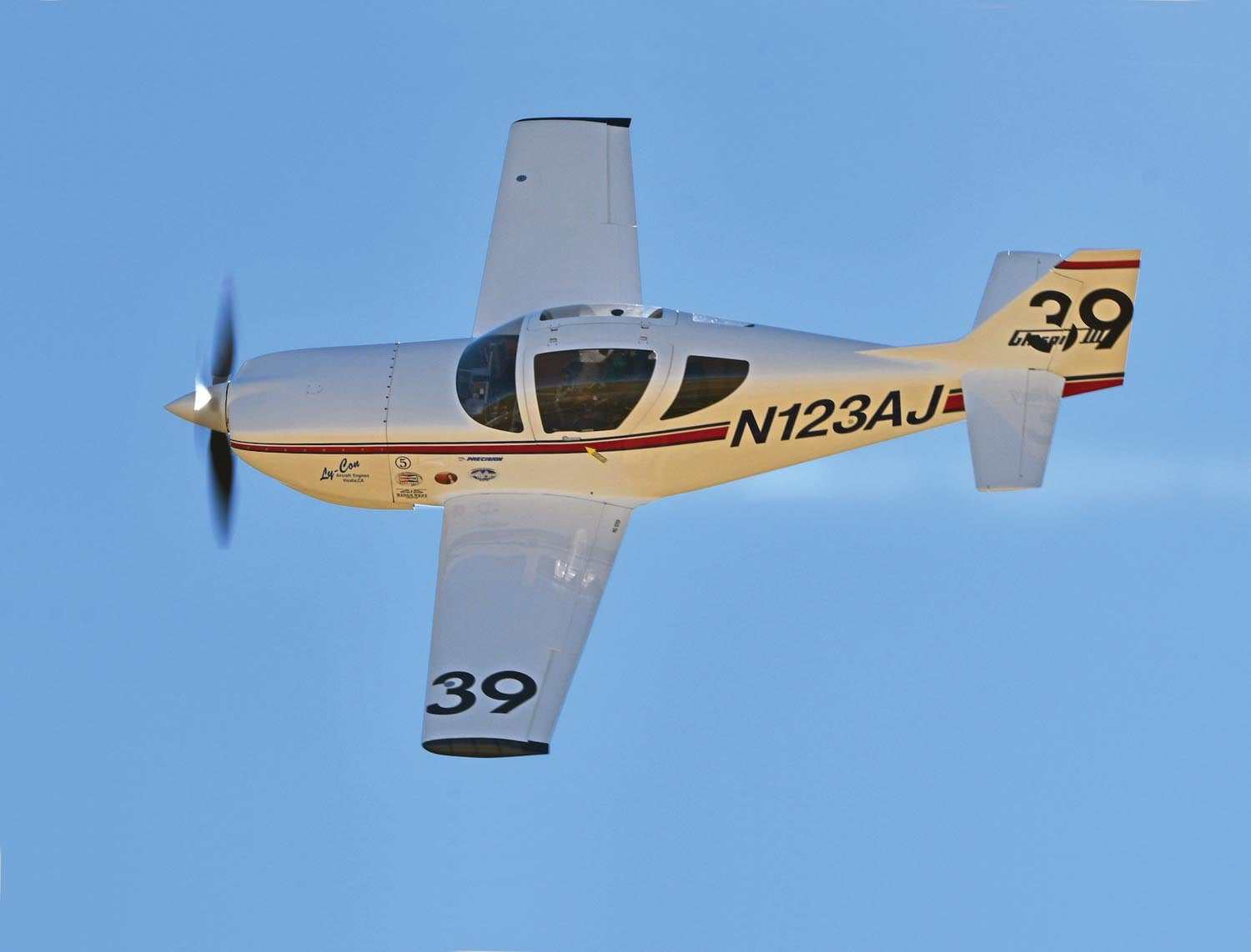
Glasair III—LaVelle
The joke in the Sport pits is that the Bonanza-like Glasair III is the box the swoopy Lancair Legacy came in—and the way to make a Legacy fast is to put it back in the box! But it’s true. The Legacy’s sharply concave aft fuselage has proven draggy and works better when filled in (the beluga belly mod), while the carton-like Glasair III needs no such streamlining. For proof, look no further than Jeff LaVelle’s Race 39 and its argument-settling eight Sport Gold championship wins, the runaway class win leader. We recently detailed this plane in the July 2023 issue, but the short version is Race 39 is a prime example of a straightforward combination honed over years of constant, sometimes seemingly minor upgrades to arrive at a near bulletproof, consistently fast racer. Attention to weight reduction from day one of the plane’s construction, then dedicating it to purely racing—Race 39 has no interior or cross country amenities—along with tons of horsepower from a long-refined Ly-Con twin-turbo Lycoming 580 are the key factors here.
Unlimited
In the mid-1960s, when Reno started, WW-II iron and supporting parts were plentiful, the technology familiar to the numerous military-trained techs and naturally the choice of better-funded aviation enthusiasts. It was arguably as “cheap” to feed a P-51 or Bearcat in those days as outfit a hot Lancair today, and so the big-block kind of guys opted for V-12 or round-motor fun. Thus, Reno’s Unlimited class was initially full of old fighters lightly modded by enthusiasts much as the Sport class is today by speed-hungry amateurs turning up the wick on Harmon Rockets, Glasairs and Lancairs. Today the venerable Unlimiteds are the stuff of legend, time and economics making them exquisitely rare and expensive. True hero-class hardware, the fighters from the big engine peak remain the fastest piston racers ever and always were the major draw to Reno’s fans.
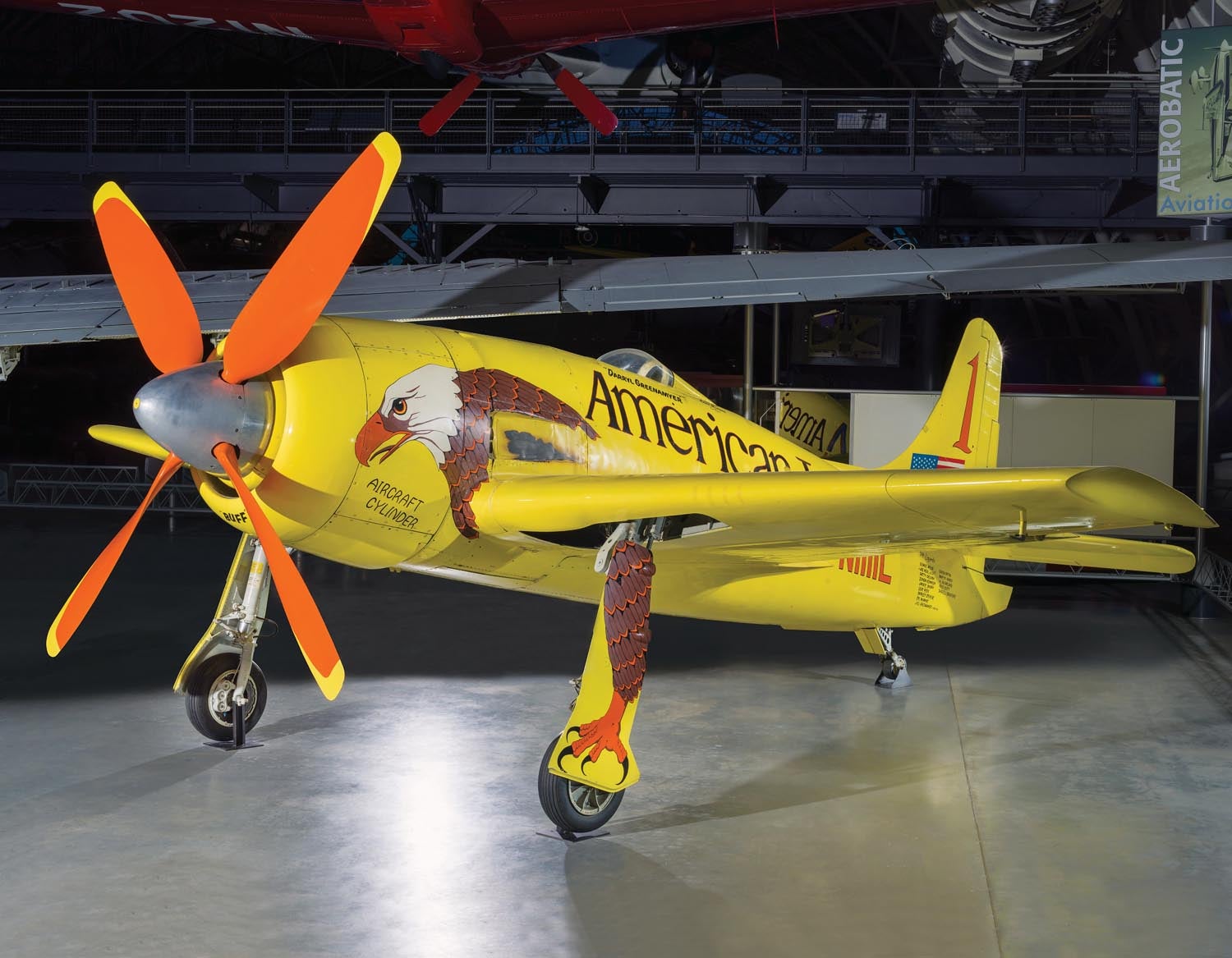
Conquest 1
Simply the baddest bear in the valley and first of the immortals, Conquest 1 was the first old fighter cut and pinched into a pure Reno racer, literally too hot to pilot bare-handed or survive without an oxygen mask and ice pack. A machine gun at a knife fight, it was the first no-excuse private-effort Unlimited that won five consecutive (really six but for a technicality) Unlimited Gold titles 1965–1969 plus a sixth in 1971, and it would have won in 1970 except a gear leg hung open. And these wins were mainly while running only just fast enough. Running at full chat, Conquest 1 reset the world’s piston-engine speed record to 483 mph in 1969.
Owner-pilot Darryl Greenamyer was straight out of central casting, too. He had the compact build and crew cut of a ’50s gearhead, he dabbled in wild 200-mph drag cars, his day job was Lockheed test pilot and he claimed over 200 hours at Mach 3 or greater. Not afraid to comprehensively modify his Bearcat, he stripped Conquest 1 to its bones, then gave it fast-acting pneumatic gear actuation, an R-2800 engine configured with a heavy transport case and the best low-altitude blower and prop reduction combination, then topped it off with water and nitromethane(!) injection plus boil-off cooling. The wings were clipped, the Skyraider prop so large it could only be landed and taken off in the three-point…Darryl and Conquest 1 bridged the Cleveland-to-Reno eras and made air racing unignorable. If any post-WW-II air racer deserves a place in the National Air & Space Museum, Conquest 1 rightfully earned its spot. And not incidentally, Greenamyer went on to four Sport Gold wins in a Lancair Legacy, giving instant legitimacy to that then fledgling class.
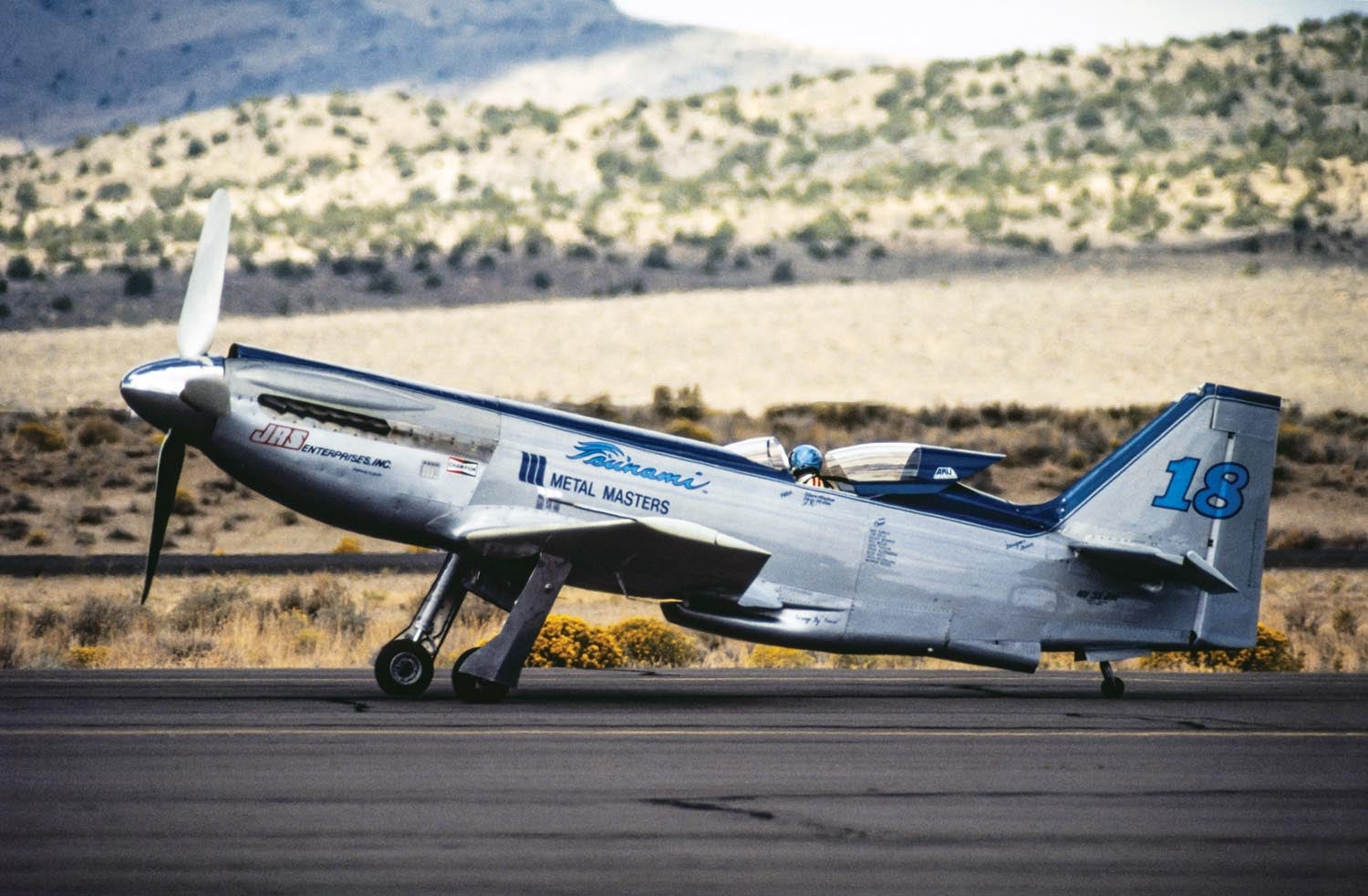
Tsunami
No doubt the greatest “what if” Reno story, Tsunami was a homebuilt from bare metal as the first clean-sheet design racer of the modern era. Of conventional aluminum construction and Merlin V-12 power, the shape took the inevitable P-51-esque layout to achieve low drag from an inherently smaller and lighter platform than its repurposed fighter competition. It showed outstanding promise and speed while working through its early teething phase only to be lost to a flap failure during a routine landing that also took the life of owner John Sandburg. Tsunami finished third in the greatest Unlimited race—the 1991 Gold final shootout among Rare Bear, Strega and Tsunami—a race run entirely at qualifying speeds and showing Tsunami was the 500-mph heir apparent. The promise was so great, an effort to resurrect Tsunami continues to this day.
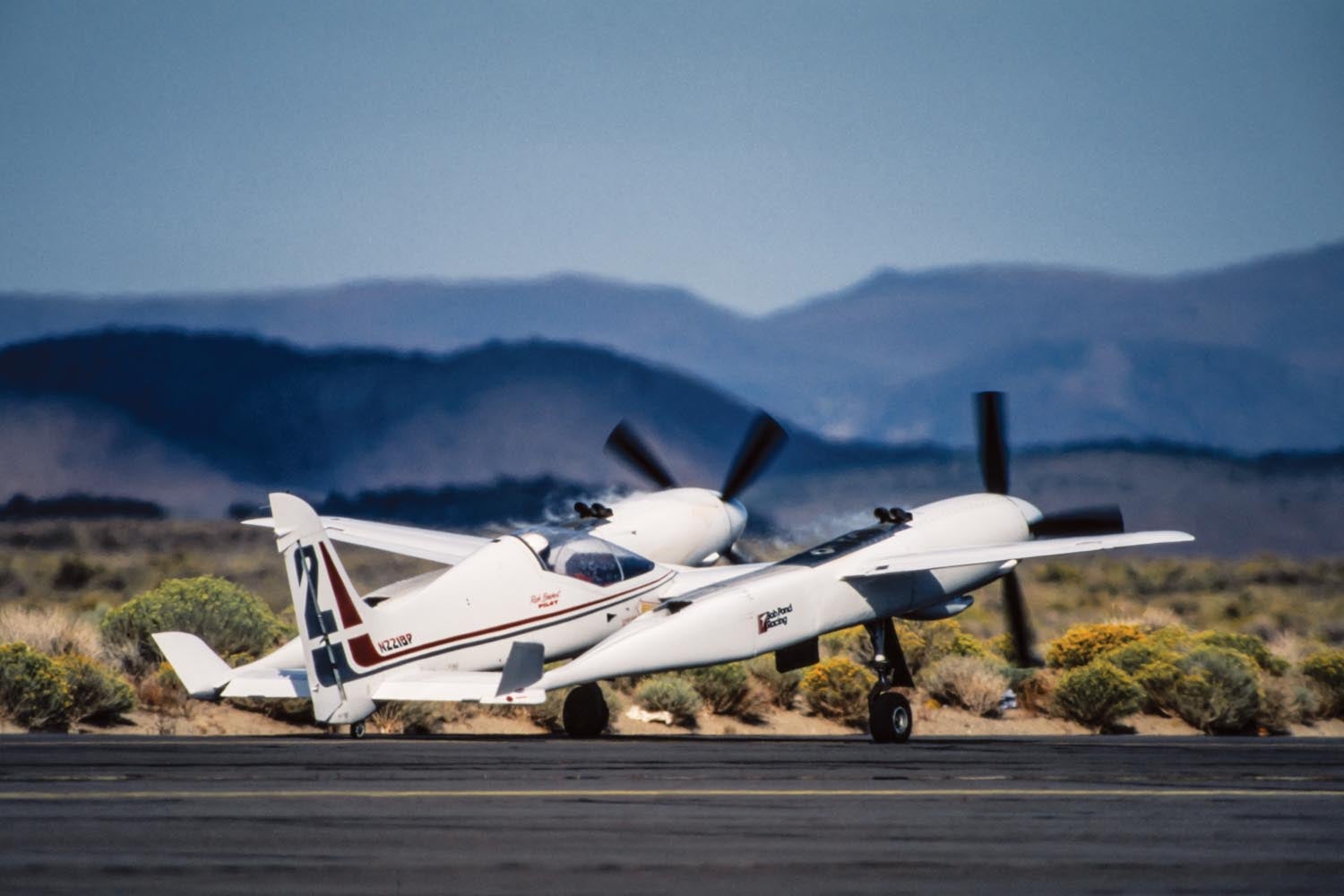
Pond Racer
Industrialist Bob Pond loved warbirds and wanted a scratch-built Unlimited racer so fast it would stop people from cutting up the old fighters for racing. So for 1991 he commissioned Burt Rutan to build the ultimate Unlimited. Overly complex and of curious layout with many intersections, the fabulously light, compact and composite Pond Racer flew wonderfully, but its major defect was the fiendishly complex Nissan car racing engines and their integration with the airframe. Brimming with devilish teething and operational issues, the Pond Racer whispered around Reno’s pylons as a perpetually disappointing Gold backmarker at less than 400 mph. After only hinting at what could be, a catastrophic engine failure killed both the machine and pilot Rick Brickert at the 1993 races. That said, it was a bold private effort to advance air racing, an Unlimited that could have advanced the sport to a smaller, lighter, more advanced future years before the advent of the Sport class. The greatest pity was the Unlimited class’s reaction to the Pond Racer: to outlaw any similar efforts in the future with a high minimum-weight rule.
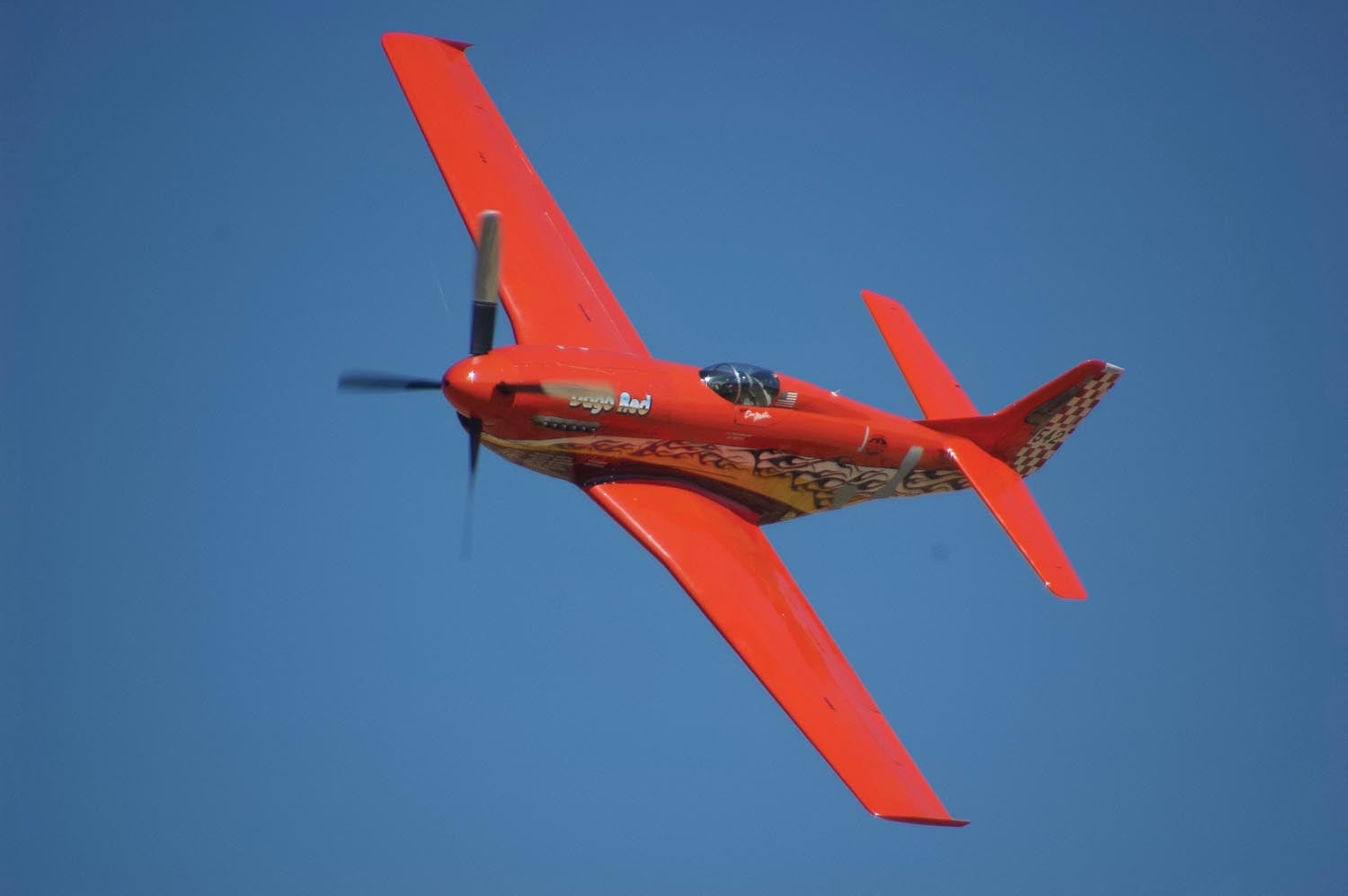
Dago Red – Strega – Voodoo
These are three different 500-mph P-51s but we’re lumping them together as all represent the pinnacle of the low-drag, water-cooled air racers and collectively they can be said to have won the air-versus-water cooling debate at Reno. Furthermore, many of the same crew members went from team to team on these three airplanes, and all three aircraft received many of the same modifications. Strega is likely the fan favorite, having won 10 Unlimited Gold titles with colorful Tiger Destefani either owning and/or piloting it, but he built and successfully campaigned the very similar Dago Red prior to Strega, which counts a lot for its pioneering value. Voodoo also boasts an impressive Reno win legacy and its record speed of 531 mph crowns what might be called a collective triumph provided by these three airplanes. All were heavily modified in the best experimental tradition, with Voodoo receiving the most advanced mods as outlined in our July 2018 feature on the plane.
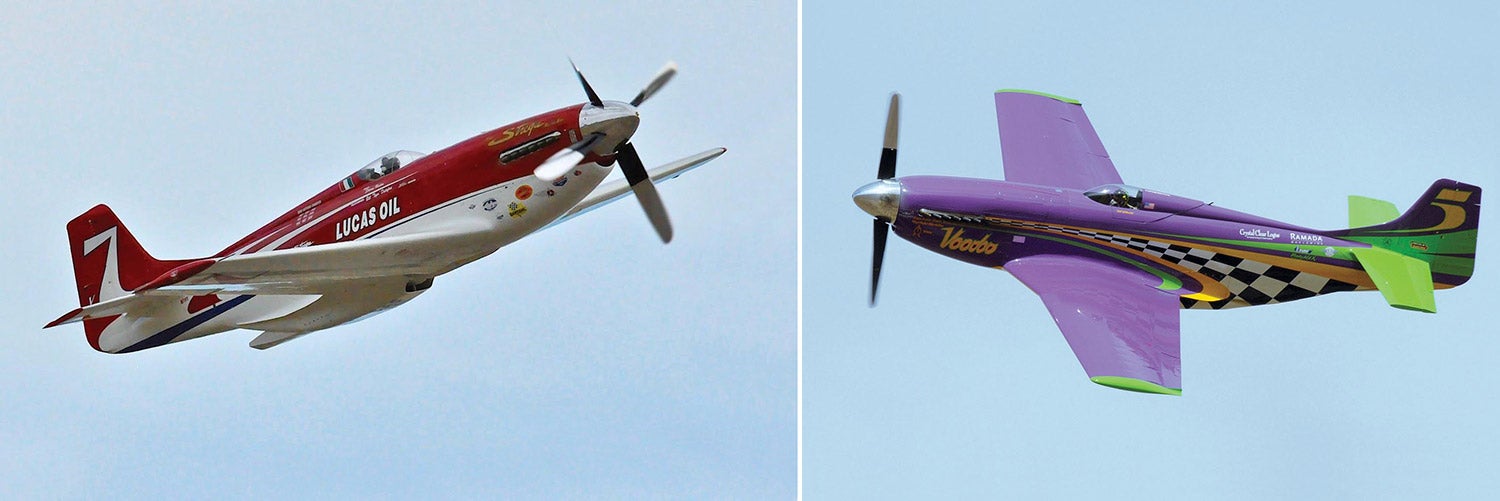
Photos: Tim O’Brien, Tom Wilson, Richard VanderMeulen and courtesy of the National Air & Space Museum.














No Tom, you missed some beautiful F1’s. Notably, the most beautiful F1, and of note, was #9 Proud Bird. One of the handful of completely new designs. I saw them all. It was much better built and more beautiful than the others. But I can’t fault you because you probably never saw her. If you did you would have added her.
it always fascinates me that no P-51A models were used as racers, that I’m aware of.
Good point as the A-model Allison was a little faster than the B-model Merlin down low. There has been an A-model racing at Reno the last two years, but it ran in apparently stock configuration so not really a gold contender. Good to hear from another Allison fan!
So much for the Griffon Superstangs….
I agree with Brent Shultz. Another beautiful F1 was the Art Williams designed Race #28 “Falcon”, piloted by Bob Downey which unfortunately crashed during practice at Reno in 1981 taking the life of Mr. Downey. The elliptical wing and curved tail surfaces blended beautifully into the fuselage.
I thought the AR-6 Endeavour set the fastest lap ever in iF1…at least 7mph faster. Also has I think the lowest frontal area of any manned propeller plane ever built at .66, that was on track to beat everything Nemesis ever did.